FORWARD, WITH FIGS
Potted Figs, but First a “Haircut”
Temperatures here have dipped into the lower 20s a few nights and still dip readily to around freezing, which might lead some of you to believe I have been neglectful of my fig trees, which are still outdoors. Not so! They are subtropical plants that can take temperatures down into the ‘teens.
Today I moved all my potted figs to their winter home. As I wrote in my book Growing Figs in Cold Climates, fig, being a subtropical plant, likes cold winters, just not those that are too, too cold. My plants went either into my basement, where winter temperatures hover in the 40s, or into my walk-in cooler (also used for storing fruits and vegetables) whose temperature is nailed at 39°.
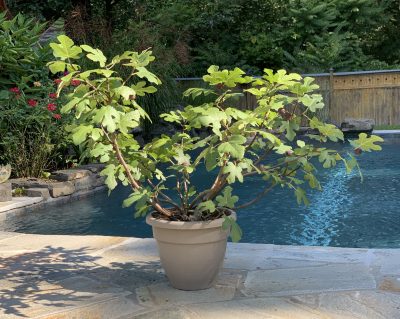
One of my friend Sara’s figs in summer
I always prune my figs before nestling them into the basement or the cooler. Then they can be carried without errant stems slapping my face, and the pots can be stored without undo elbowing neighboring potted figs.
Correct pruning now or late winter is key to reaping a good harvest next year. Keep in mind two kinds of pruning cuts, which actually applies to all plants when leafless. A heading cut, which removes only part of a stem, coaxes new growth from the remaining portion of the stem, so is useful where you want branching and new growth. A thinning cut is the complete removal of a stem; nothing obvious happens except the stem has been removed, so this kind of cut is useful to reduce the number of stems when they are too congested.
More specifically, for fig pruning, here are some pruning guidelines condensed and adapted from my book,which includes a whole chapter on pruning figs:
Some fig varieties — most varieties, in fact — bear a “main crop” on new, growing stems; some varieties bear a “breba crop” on one-year-old stems; and some varieties bear on both ages of stems, yielding both a “main crop” and a “breba crop.”
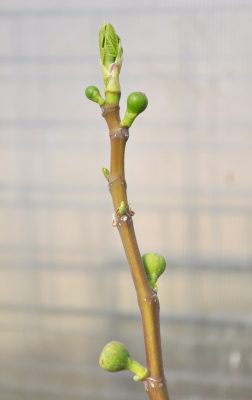
Young breba figs
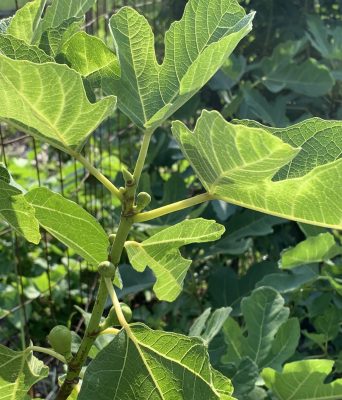
Young main crop figs
(The breba crop ripens early in the season; the main crop, from late summer on.)
For main crop figs, make thinning cuts of all stems growing from ground level or off the trunk(s) below about 2 feet height, and heading cuts back to a few inches long if you’re going for a main crop only.
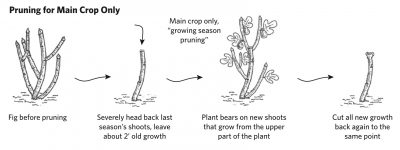
Because the breba crop forms on one-year-old stems, pruning a plant for a breba crop demands more restraint. Leave enough stems for a good breba crop in the coming season. Also plan for a future crop by heading back some stems to coax new growth this coming season for a supply of breba-bearing, one-year-old stems next season.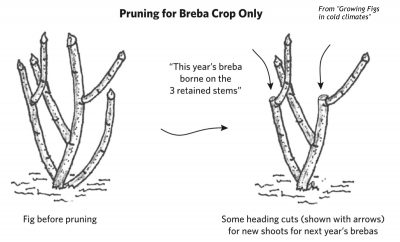
Some examples from today’s pruning might further clarify. For the variety Kadota, which bears mostly a main crop, I prune severely. A plant can be trained to have one to three trunks (I do one). Pruning is easy. Completely remove (thinning cuts) all growth, except for the trunk(s), that originates below a couple of feet above ground level, then drastically shorten (heading cuts) back to one or two buds any growth from the top of that trunk or trunks.
At the other extreme is the variety Verte, also known as Green Ischia, which bears only a breba crop. I leave lots of one-year-old stems, but also shorten a couple or so of them to coax sufficient new growth that will be one-year-old, breba-bearing stems two years hence. 
And then there are a number of fig varieties — Excel, Genoa, Celeste, and Honey, for example — that split the difference, bearing both main and breba crops each season. Splitting the difference is also the road to take when pruning these varieties..
In the (Green)house
I’m not yet finished with figs for the season. In my greenhouse, where winter temperatures are allowed to dip to a still fig-friendly 35° on cold nights, my four fig plants are trained as espaliers. Espalier is the training of plant stems to an orderly and attractive design. In the case of fruit plants, this two or three dimensional design is also very productive.
My fig plants each have a single, permanent trunk about 18” high. From the top of this trunk extends two permanent, horizontal arms in opposite directions, or a single, permanent, horizontal arm. Each year new shoots grow vertically, with some help from me and bamboo poles, along which new figs develop and ripen. Main crop figs, obviously.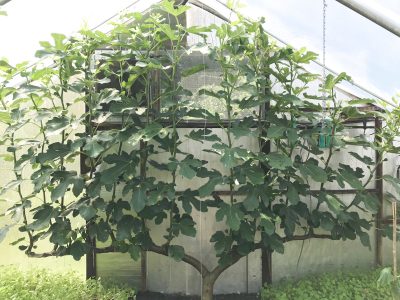
Pruning is super simple. Today I cut all those shoots back to the horizontal arms. Done. Fini. Finito. Terminado.
And Outside, in the Ground!
Still not finished with figs for the season. Although winter air temperatures are too frigid for figs here in zone 5a, ground temperatures are not. Making use of warmth from ground, I’ve trained two fig plants just like those in my greenhouse, except with trunks a few inches or less above ground level.
Soon I will cut all vertical shoots from the permanent, horizontal arms. These low plants are then easy to cover with some sort of insulation — autumn leaves, for instance — topped with a waterproof cover to keep out rainfall and hold leaves in place.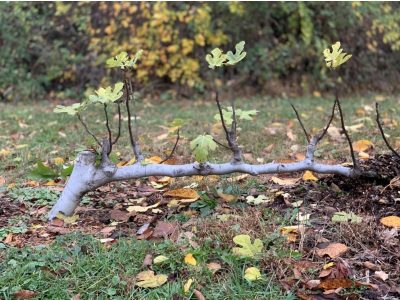
The winter home of these in-ground figs could, unfortunately, provide food and lodging for rodents. I’ll avoid this by putting off covering the plants until weather turns colder and the animals are likely to have already secured their winter quarters elsewhere. I’ll also spray the plants with Bobbex, a very effective repellent. And I’ll cut lots of mint from my still-green mint plants to strew under the figs. Rodents reputedly stay away from mint. I hope so.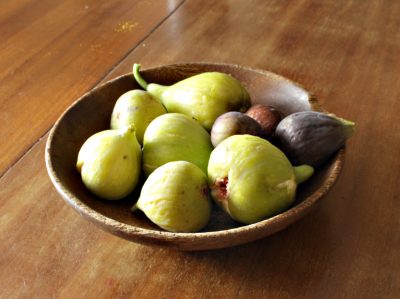

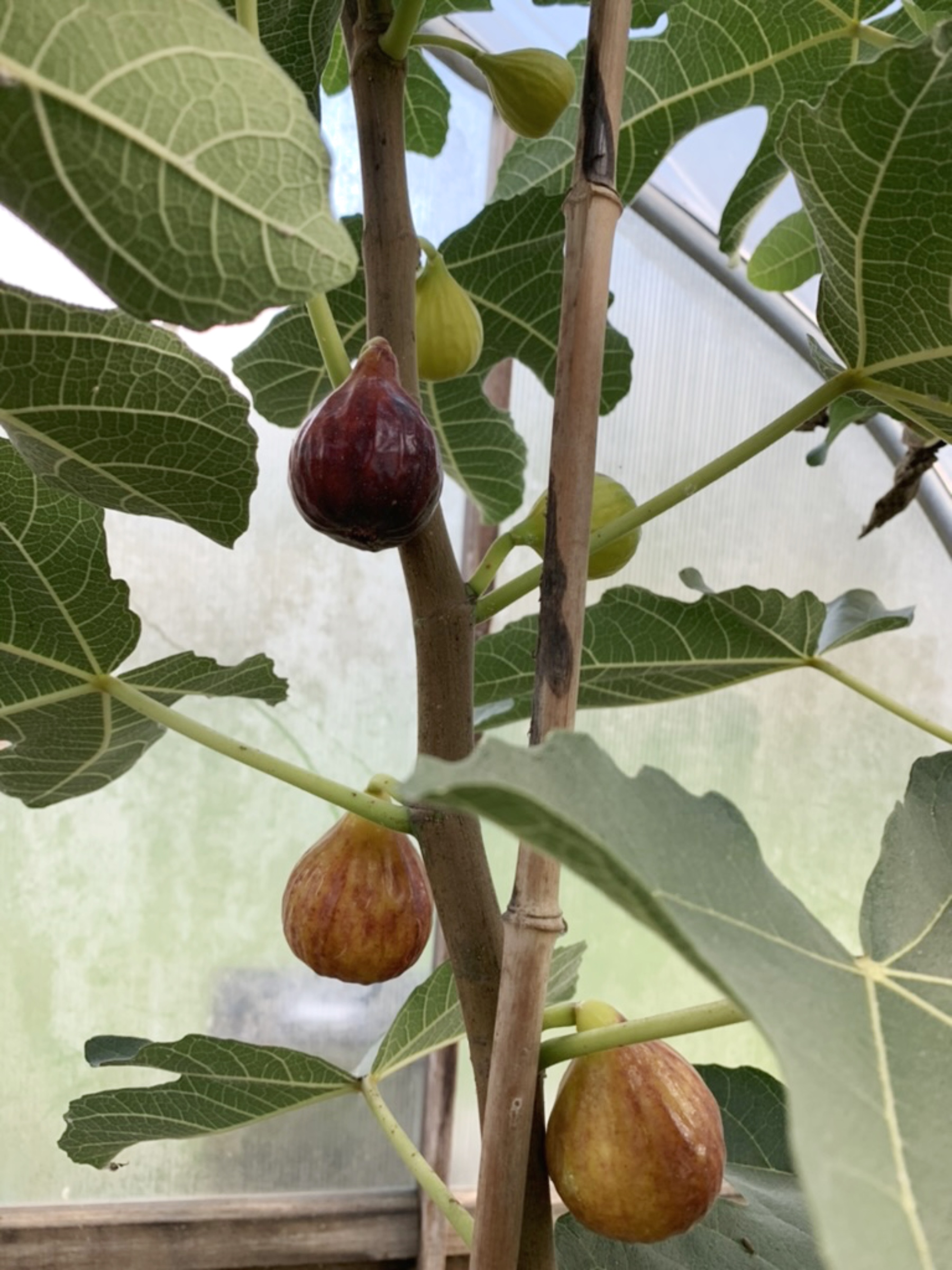

I have a purple fig which is probably 8 years old and I cannot get this tree to ripen its fruit. Right now it has about 50 very small unripe fruits I need to snip off before I cut back the tree in the spring. Near it, is a white fig which bears heavily and everyg fruit ripens in proper sequence. Any advice about the purple fig? Thank you.
There are lots of purple figs. Another variable is the length of your growing season. Without any further information, I’d suggest leaving a couple of stems shortened to no less than 3 feet above ground level or left full length. New shoots that arise higher off the ground ripen their fruits earlier than stems arising lower.